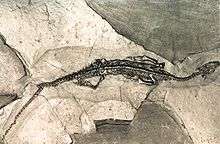Pachypleurosaur
Pachypleurosaurs were primitive sauropterygian reptiles that vaguely resembled aquatic lizards, and were limited to the Triassic period. They were elongate animals, ranging in size from 20 cm to about a metre in length, with small heads, long necks, paddle-like limbs, and long deep tails. The limb girdles are greatly reduced, so it is unlikely these animals could move about on land. The widely spaced peg-like teeth project at the front of the jaws, indicate that these animals fed on fish.
| Pachypleurosaurs Temporal range: Triassic | |
|---|---|
 | |
| Keichousaurus | |
| Scientific classification | |
| Kingdom: | Animalia |
| Phylum: | Chordata |
| Class: | Reptilia |
| Superorder: | †Sauropterygia |
| Order: | †Nothosauroidea |
| Suborder: | †Pachypleurosauria Nopcsa, 1928 |
| Genera | |
| |
Pachypleurosaurs were originally and are often still included within the Nothosauroidea (Carroll 1988, Benton 2004). In some cladistic classifications however (Rieppel 2000), they are considered the sister group to the Eusauropterygia, the clade that includes the nothosaurs and plesiosaurs.
Sources
- Benton, M. J. (2004), Vertebrate Paleontology, 3rd ed. Blackwell Science Ltd
- Carroll, R.L. (1988), Vertebrate Paleontology and Evolution, WH Freeman & Co.
- Rieppel, O., (2000), Sauropterygia I, placodontia, pachypleurosauria, nothosauroidea, pistosauroidea: In: Handbuch der Palaoherpetologie, part 12A, 134pp. Verlag Dr. Friedrich Pfeil Table of contents
External links
- Lepidosauromorpha: Pachypleurosauridae - Palaeos
References
- Jun Liu; Olivier Rieppel; Da-Yong Jiang; Jonathan C. Aitchison; Ryosuke Motani; Qi-Yue Zhang; Chang-Yong Zhou; Yuan-Yuan Sun (2011). "A new pachypleurosaur (Reptilia: Sauropterygia) from the lower Middle Triassic of southwestern China and the phylogenetic relationships of Chinese pachypleurosaurs". Journal of Vertebrate Paleontology. 31 (2): 292–302. doi:10.1080/02724634.2011.550363.
- Renesto, S.; Binelli, G.; Hagdorn, H. (2014). "A new pachypleurosaur from the Middle Triassic Besano Formation of Northern Italy". Neues Jahrbuch für Geologie und Paläontologie - Abhandlungen. 271 (2): 151. doi:10.1127/0077-7749/2014/0382.
